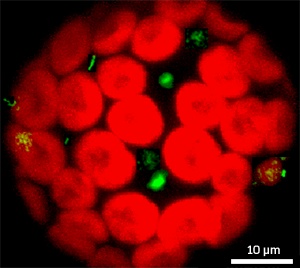A nanotube transporter could potentially carry biomolecules to specific locations within plant cells without degradation

Carbon nanotubes have emerged as useful tools for delivering biomolecular cargo to specific locations in animal and plant cells. The main challenges in achieving this kind of targeted delivery are getting the nanotubes through the outer cell membrane and then avoiding entrapment by subcellular structures such as endosomes that would otherwise degrade them.
A team of researchers led by Maged Serag and Yoshinobu Baba from the Nagoya University FIRST Research Center for Innovative Nanobiodevices has assessed the capability of multiwalled carbon nanotubes (MWCNTs) to penetrate the cell membrane of protoplasts–plant cells that have been treated with enzymes to remove their outer cell wall, which normally blocks large molecules from entering the cell.
Carbon nanotubes can host a wide variety of biomolecules, and their toxicity to organisms can be reduced by adding functional chemicals. Single-walled CNTs have been shown to be able to enter plant cells by penetrating their cell walls and membranes. Similarly, MWCNTs can penetrate tomato seeds, increasing their germination and growth rates. However, most previous experiments focused on bacterial and mammalian cells.
"We wanted to know whether MWCNTs could cross the plant cell membrane and avoid destruction by endosomes, and also where they ended up within cells," says Serag.
To do this, the researchers performed experiments with plant protoplasts prepared using cells from the Madagascar periwinkle (Catharanthus roseus). Substances extracted from this species are used to treat many diseases, including leukaemia, but the plant is difficult to transform genetically.
The researchers incubated protoplasts with short MWCNTs labeled with a fluorescent marker. They then used a technique called confocal microscopy to reconstruct three-dimensional images, allowing them to follow the fate of MWCNTs within the protoplasts (Fig. 1). They also used electron microscopy to confirm the subcellular distribution of the nanotubes.
The team observed that the MWCNTs readily entered the protoplasts and targeted specific cell compartments, including the cell nucleus. Other targets included sack-like vacuoles, and structures called plastids used for photosynthesis and starch storage.
Importantly, the researchers found that MWCNTs entered the cells passively through the cell membrane rather than following a route involving endosomes, which they had also labeled with a fluorescent dye. This capability allowed the MWCNTs to reach their destination without significant risk of destruction en route.
"Our demonstration that MWCNTs can cross the cell membrane and target particular cell compartments without being degraded should have a significant impact on plant cell biology and transformation technologies," said Serag.
Affiliated Researchers
The Nagoya University affiliated authors mentioned in this highlight are from the FIRST Research Center for Innovative Nanobiodevices
Reference
- Serag, M. F. et al., Trafficking and subcellular localization of multiwalled carbon nanotubes in plant cells. ACS Nano Published online: 8 Dec 2010 | DOI: 10.1021/nn102344t | article
